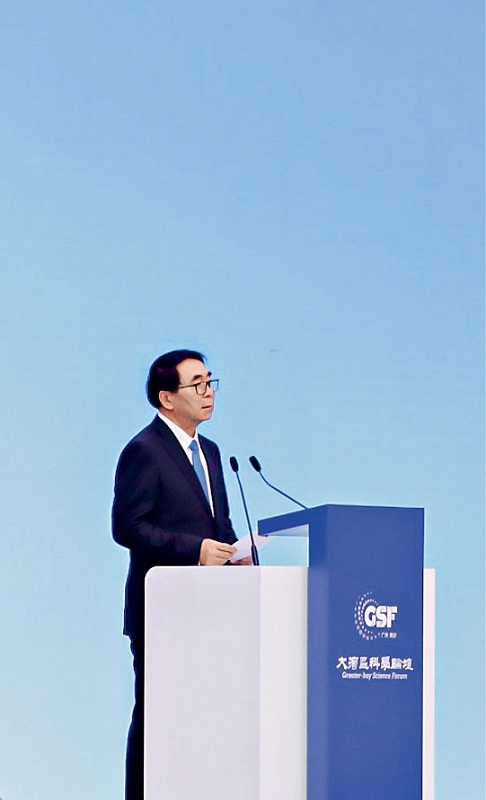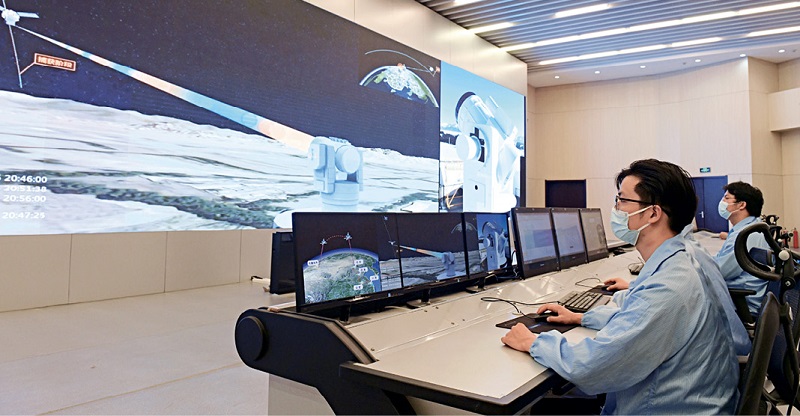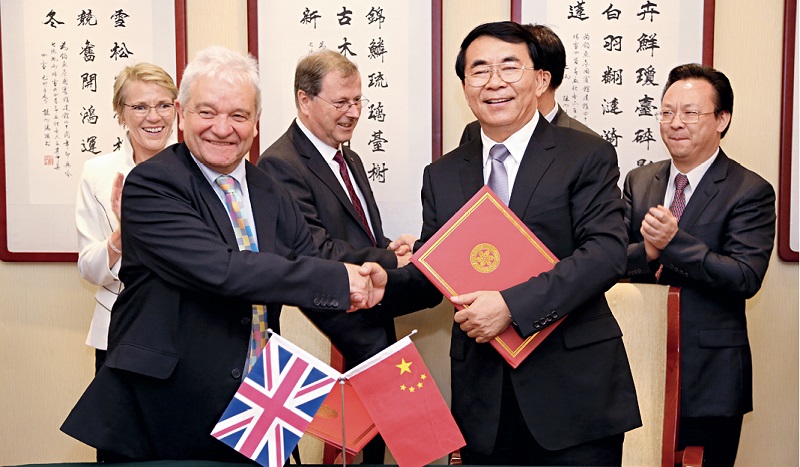Chinese eminent scientist Bai Chunli talks about China’s initiatives to create global platforms for sci-tech cooperation.

Bai Chunli, president of the Alliance of International Science Organizations (ANSO), delivers a speech at the first Greater Bay Area Science Forum on December 11, 2021.
Most people make several phone calls a day and very few keep records of the date and time. But the call made between Austrian physicist Anton Zeilinger, who won the Nobel Prize in physics this year, and Bai Chunli, then president of the Chinese Academy of Sciences (CAS), on September 29, 2017, has gone down in the annals of quantum science as the first intercontinental quantum-secure communication video call. Bai was in Beijing and Zeilinger in Vienna, and the communication was possible through a sophisticated Chinese research satellite named Micius, the world’s first quantum communication satellite developed and launched into orbit by the CAS just the year before.
Zeilinger is a CAS academician; so is American scientist K. Barry Sharpless, who won his second Nobel Prize in chemistry in 2022. Zeilinger is also an academician of The World Academy of Sciences (TWAS), an Italy-based international organization promoting scientific capacity and excellence for sustainable development in developing countries. In September 2012, Bai was elected president of TWAS, a position he would hold for two consecutive terms till 2018, becoming the first Chinese scientist to have that honor.
China Today recently had an interview with the eminent scientist at the International Forum on South-South Cooperation and Trade in Services in Beijing in September, where he was wearing yet another hat: president of the Alliance of International Science Organizations (ANSO) in the Belt and Road Region. In this exclusive interview, Bai talked about international cooperation in science and technology and China’s efforts in creating global platforms for sci-tech collaboration.

Staff members work at the general control center of the quantum communication line, known as the Beijing-Shanghai Trunk Line, connected to the world’s first quantum satellite in Hefei, Anhui Province on May 19, 2022.
Ten Years of Efforts
Bai called 2012 an epochal year in the history of science in China. “That year, the CAS launched its going global strategy, aiming to elevate sci-tech exchanges and cooperation with developing countries. Another big event was the 18th National Congress of the Communist Party of China (CPC) in November, where the CPC Central Committee decided that promoting sci-tech innovation with a global vision would be a national strategy.”
The following year, President Xi Jinping proposed the Belt and Road Initiative (BRI) and it received a positive response from more than 100 countries. These were mostly countries facing challenges on transitioning to sustainable and innovation-driven development. International cooperation in science and technology was regarded as a golden key for their development. In November 2016, Beijing hosted the first International Science Forum of Scientific Organizations on the BRI to discuss how to go about it. The forum decided to establish ANSO as a permanent mechanism for sci-tech cooperation among the BRI countries. Representatives from the CAS, UNESCO, the Russian Academy of Sciences, and the Polish Academy of Sciences among others signed to join the alliance.
“On November 4, 2018, we announced the official establishment of the ANSO,” Bai said. “President Xi sent a congratulatory letter and Vice Premier Liu He attended the meeting.” There were 37 founding members, including international organizations and national academies of sciences, national research institutions, and universities from 32 countries.
As the first president of the ANSO, Bai is dedicated to better aligning incentives for technological innovation with development strategies, boosting sustainable socioeconomic development, and building an international community with a shared future in science and technology. At the second Belt and Road Forum for International Cooperation held in 2019, the establishment of the ANSO as a platform for multilateral scientific cooperation was among the major deliverables of the forum.
China is building up its strengths in science and technology, and striving to emerge as a leading country of innovation. Over the past decade, R&D expenditure grew rapidly under the national strategy of innovation-driven development. In 2021, China ranked 12th in the Global Innovation Index, up from the 34th place in 2012. At the same time, it is also promoting international exchange and cooperation in science and technology.
“Over the past two years, we have kept a close eye on global issues, such as climate change, public health, food security and the transformation of energy mix,” Bai said. When the COVID-19 pandemic struck, the secretariat of the ANSO promoted cooperation of its members on vaccine research, focusing on the Phase III clinical trials of the recombinant protein COVID-19 vaccine developed by the CAS.
Ibrokhim Abdurakhmonov, Minister of the Innovative Development of Uzbekistan and also academician of TWAS, has maintained close contacts with the ANSO. Thanks to his support, Uzbekistan approved the use of the Chinese vaccine on March 2, 2021, saying that the Chinese vaccine is one of the safest and most effective vaccines globally.
When President Xi visited Uzbekistan in September ahead of the 22nd Summit of the Shanghai Cooperation Organization in Samarkand, he mentioned this in a signed article published in the local media. “Chinese vaccines, which can now be jointly produced with Uzbekistan, have played a major role in Uzbekistan’s fight against the virus, and a Chinese anti-virus drug has been approved for clinical use in Uzbekistan, providing effective protection for people’s life in both countries,” the article reads.
Today, the ANSO has 67 members from 48 countries and regions. It has implemented 25 major international joint scientific programs and set up a science foundation open to research institutions across the world. Research institutions from more than 70 countries have been involved in programs funded by the foundation. “We have built 19 international professional platforms, including the Alliance of International Science Organizations on Disaster Risk Reduction, and the Association for Trans-Eurasia Exchange and Silk Road Civilization Development, helping Chinese scientists play a greater role on the global sci-tech stage,” said Bai.

Bai Chunli, then president of the Chinese Academy of Sciences, signs a joint statement with the visiting President of the Royal Society Sir Paul Nurse to promote and support cooperative research between China and the U.K. on September 13, 2013.
Going Global
In response to the BRI, the CAS has promoted cooperation in such fields as health and biomedicine, water treatment, clean energy, climate change, and environmental and ecological protection.
The cooperation focuses on three aspects: solving key technological problems in the construction of major projects along the Belt and Road route; providing sci-tech solutions to improve the livelihoods of local people; and pooling research resources for major scientific research. The CAS has thus established an international cooperation network which integrates projects, researchers, and research platforms. The efforts enhanced China’s capability to participate in global science and technology governance, as well as the country’s global influence and soft power.
“A large number of academicians have made outstanding contributions to promoting capacity building in scientific research in developing countries, and pushing forward South-South cooperation and North-South cooperation. They have also played a leading role in solving global issues,” Bai said.
The Third Pole Environment Research Program is an example. The Tibetan Plateau and its surroundings, including some of the highest mountains in Asia that are the sources of major rivers, is regarded as the Third Pole. The project, led by CAS academician Yao Tandong and supported by UNESCO and UNEP, assesses the environmental changes in this region and the threats it faces. The project has built an international cooperation system and observation network involving scientists from more than 30 countries. Meanwhile, five science centers have been established in Beijing in China, Kathmandu in Nepal, Columbus in the United States, Gothenburg in Sweden, and Frankfurt in Germany.
To foster the people-to-people exchange that is essential for international cooperation, Bai initiated the CAS President’s International Fellowship Initiative and the CAS-TWAS President’s PhD Fellowship. The two programs fund researchers from developing countries to study in China for short-term scientific and technological exchanges. The CAS and the University of the Chinese Academy of Sciences worked with the Danish Ministry of Science, Technology and Innovation and eight Danish universities to found the Sino-Danish Center for Education and Research with the aim of promoting academic exchanges between China and Denmark. ANSO scholarships have helped over 1,000 students working on doctoral and master programs from more than 100 countries, facilitating the mobility of talented scientists across the globe.
In addition, the CAS has built 10 overseas science and education bases in Asia, Africa, and Latin America, and set up five CAS-TWAS excellence centers to work in a wide range of areas, from water and environment to biotechnology and disaster reduction and prevention. In 2013, the CAS South America Center for Astronomy was founded to develop collaboration on astronomy research between China, Chile and other South American countries.
Aiming Higher
In September 2021, Chinese President Xi Jinping proposed the Global Development Initiative in his speech delivered via video at the general debate of the 76th session of the UN General Assembly. Three months later, the first Greater Bay Area Science Forum (GSF) sponsored by the ANSO was convened in Guangzhou in south China. In his congratulatory letter, Xi said the new round of sci-tech revolution and industrial transformation has exerted a profound impact on the global economic structure. The Guangdong-Hong Kong-Macao Greater Bay Area should revolve around its central task of building an international sci-tech innovation center and facilitate the development of emerging industries.
Bai said the GSF has created a high-level exchange platform for statesmen, leading scientists, entrepreneurs, and financial professionals to share their insights. Two Nobel laureates and 130 well-known academicians shared their latest research achievements on such topics as COVID-19 prevention and control and pharmaceutical R&D. Richard John Roberts, winner of the 1993 Nobel Prize in physiology or medicine and chairman of the Laureate Science Alliance, said that the R&D of COVID-19 testing reagents and vaccines depended on the genome sequencing of the virus released by Chinese researchers in early 2020. This is an excellent example of how scientific collaboration and cooperation can help the whole world, he said.
What would be the key areas for future international cooperation in science and technology? Bai said the new energy technology has huge potential and will speed up the transition to a green, low-carbon, safe and efficient energy mix. Artificial intelligence is another booming sector, given China’s huge number of mobile Internet users and high penetration of online payment. In the field of health sciences, disruptive technologies that would lead to an industrial transformation are emerging. For example, in brain science, which is seen as the “last frontier” of natural science research, scientists have mapped the human brain and realized direct control over artificial limbs through brain-computer interfaces, laying the foundation for creating new methods for the diagnosis and treatment of neurological and mental diseases.
Lingshan Island in Guangzhou has been chosen as the permanent site for the GSF because of its ideal location, which makes collaboration with Hong Kong and Macao, and even beyond very convenient. Bai expects that the GSF will be built into a Davos forum in science. “We will gather global scientists, scientific organizations, and all sectors of society to strengthen sci-tech cooperation, encourage innovation, share achievements, and more importantly, break the barriers restricting the free flow of factors for production, such as knowledge, technology, and talents,” he said. The ultimate goal is “to build an open and inclusive innovation ecosystem” and “make scientific achievements available to the people, and shared and used by the people.”